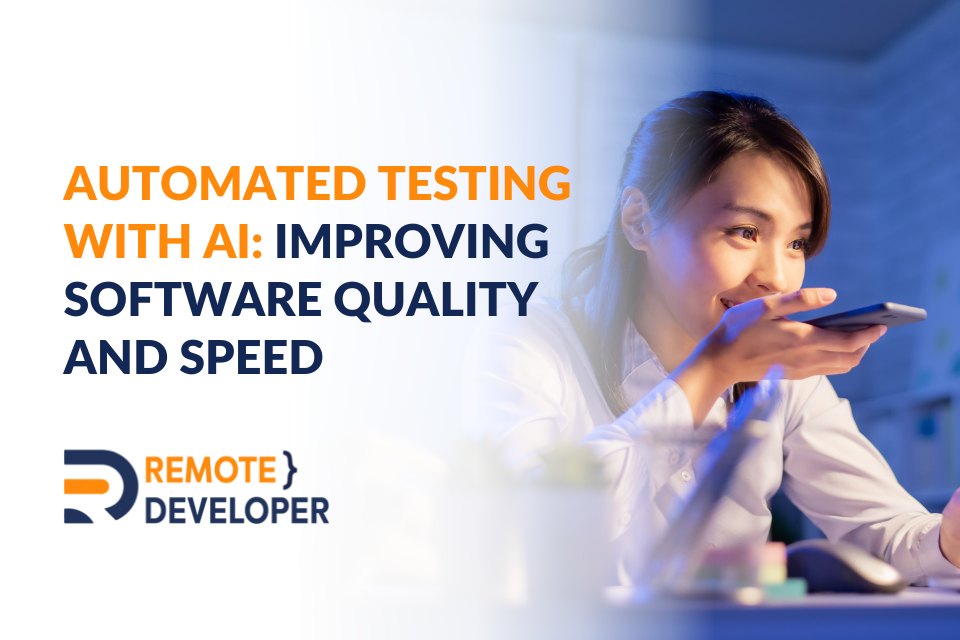The software development landscape is constantly changing and increasingly becoming more competitive. With that, delivering error-free and efficient applications swiftly is more crucial than ever.
Amid this, Artificial Intelligence (AI) has introduced a paradigm shift in automated testing. It revolutionised traditional testing methodologies to enhance the speed and quality of software testing processes. Through AI, developers and quality assurance (QA) teams can harness advanced technologies like machine learning (ML), natural language processing (NLP), and predictive analytics. These technologies not only automate routine tasks but also bring intelligent analysis capabilities that transform how testing is conceived and executed.
Thus, in this article, we will explore the profound impact of AI in automated testing, discussing its fundamental mechanisms, leading tools, benefits, and strategic implementation methods to help organizations stay ahead in the technological race.
The Basics of AI in Automated Testing
Artificial Intelligence (AI) has emerged as a transformative force in software testing, altering the landscape of traditional methodologies. The application of AI in automated testing encompasses a range of technologies, such as machine learning (ML), natural language processing (NLP), and predictive analytics. These technologies enable automated systems to perform tasks that require human intelligence, significantly improving the efficiency and effectiveness of testing processes.
That said, here are the differences between the three:
1. Machine Learning (ML)
Machine learning in automated testing primarily focuses on optimising test cases and predicting future test outcomes based on historical data. ML algorithms can automatically generate and optimise test scripts, making the testing process faster and more effective. According to a study by Capgemini, machine learning can reduce the time required for test analysis and design by up to 40%.
2. Natural Language Processing (NLP)
Natural Language Processing allows testers to create test cases in plain English, which the AI then converts into executable test scripts. This dramatically simplifies the test creation process and makes it accessible to individuals who may not have coding expertise. According to recent industry reports by Gartner, NLP can increase the speed of test creation by up to 50%.
3. Predictive Analytics
Predictive analytics utilises past data to predict defects and identify the most critical areas for testing. By focusing on these high-risk areas, companies can ensure that their testing efforts are both effective and efficient. According to IBM’s The Future of Testing study, predictive analytics can improve defect detection rates by up to 35%, significantly reducing the likelihood of software failures in production.
5 Leading AI Testing Tools
There are several AI-driven tools in the field of automated testing. These tools can enhance the efficiency and effectiveness of testing processes. Here’s an overview of five leading AI testing tools that are transforming software quality assurance:

1. Testim.io
Testim.io utilizes machine learning to speed up the creation and maintenance of automated tests. This tool learns from data to improve test stability over time, automatically adjusting tests based on UI changes and usage patterns. It’s particularly noted for reducing the maintenance burden by predicting and fixing flaky tests before they fail.
According to user reviews and case studies, Testim.io can reduce test maintenance time by up to 70% and increase the speed of test creation by a similar margin.
2. Applitools
Applitools integrates AI in automated testing by providing advanced visual testing solutions. This ensures that apps appear correctly across all devices and browsers. This tool uses AI to detect visual discrepancies with pixel-perfect accuracy, a critical factor in maintaining consistent user experience. Applitools’ AI algorithms can also automatically update visual baselines, saving testers significant time and reducing the chance of human error in visual validation.
3. mabl
Mabl offers an end-to-end testing solution where AI in automated testing plays a central role in every aspect of the software lifecycle. From test creation to analysis of results, mabl uses machine learning to identify anomalies, predict key areas of risk, and provide insights into the root causes of issues.
The tool’s self-healing capability adjusts tests dynamically as the application under test evolves, thereby decreasing the need for manual test maintenance.
4. Functionize
Functionize uses natural language processing to allow testers to create tests using plain English, which makes test automation accessible to non-developers. The platform employs sophisticated machine learning models to analyze test data, optimize test execution, and predict potential failures before they occur.
Likewise, Functionize’s architecture supports complex testing scenarios and integrates seamlessly with CI/CD pipelines, enhancing both the speed and robustness of testing processes.
5. Parasoft SOAtest
Parasoft SOAtest is an AI-driven tool that focuses on API testing, crucial for ensuring that different software systems communicate effectively. It uses AI to automate test creation, execution, and analysis, particularly in complex microservices environments.
By employing AI to analyze traffic patterns and simulate realistic API usage scenarios, Parasoft SOAtest helps teams achieve comprehensive API test coverage and enhances the reliability of integration testing.
5 Benefits of AI-Driven Testing
The integration of Artificial Intelligence (AI) into automated testing processes offers a multitude of benefits that can significantly enhance the efficiency, accuracy, and overall effectiveness of testing cycles. Here are five key benefits of AI-driven testing:
1. Enhanced Efficiency
AI-driven testing tools can automate complex and repetitive tasks, significantly reducing the time required for test execution. This capability reduces the test cycle time, allowing for more frequent releases. For instance, AI can automatically generate and optimize test cases or scripts, reducing the setup time from days to mere hours.
In addition, it also increases efficiency enabling faster releases and a quicker time-to-market, which is crucial in today’s fast-paced development environments.
2. Improved Accuracy and Reliability
AI algorithms help minimise human errors in test case design and execution. How? Well, tools use advanced algorithms to ensure that the tests are executed correctly and cover more ground. They can consistently execute predefined actions, compare results, and report outcomes with high precision.
For example, visual testing tools powered by AI can detect even the smallest discrepancies in UI elements that manual testing might miss.
3. Adaptability
AI-driven testing tools can adapt to changes in the application or environment without human intervention. This adaptability is crucial in agile development environments where application features change frequently.
4. Cost Reduction
Automating the testing process reduces the reliance on manual testing, which can be costly and time-consuming. How so? Well, according to Forrester, companies that implement AI in their testing processes often see a reduction in testing costs by up to 30%.
This reduction in human resources leads to significant cost savings over the life of a project. Additionally, AI-driven testing can detect defects earlier in the development cycle, reducing the cost associated with late-stage bug fixes, which are generally more expensive to resolve.
5. Continuous Improvement
AI-driven testing tools learn from previous test runs and continuously refine their testing strategies and algorithms. This continuous learning process helps identify new patterns of failure, anticipate potential future issues, and suggest improvements.
Over time, the AI models become more efficient and effective at predicting and mitigating risks, leading to progressively better outcomes in subsequent testing cycles.
How to Implement AI in Your Testing Processes?
Implementing AI in your testing processes can significantly enhance efficiency, accuracy, and effectiveness. However, to successfully integrate AI, a structured approach is necessary. Here are key steps to guide you through the implementation of AI in your testing processes, with references and resources for deeper insights:
- Assess Your Testing Needs. Start by evaluating your current testing processes to identify areas where AI can benefit most. Consider factors such as test volume, complexity, and the frequency of application changes. Understanding these factors will help determine where AI can improve efficiency or accuracy.
- Select the Right AI Testing Tools. Choose AI testing tools that align with your specific needs. Consider tools that integrate easily with your existing testing frameworks and support the technologies you use. Strong community and vendor support is also essential.
- Skill Development and Training. Ensure that your team has the necessary skills to work with AI-driven testing tools. This may involve training sessions on AI basics, machine learning, and specific training for your chosen tools.
- Pilot Project. Implement AI testing tools on a small scale initially. Choose a pilot project that is manageable but significant enough to provide insights into how AI can impact your testing processes. This approach allows you to assess the effectiveness of AI testing tools without widespread disruption.
- Integrate and Scale Up. After successful pilot testing, AI testing tools will gradually be integrated into more projects. Scaling up systematically is important to monitor the impact and make adjustments as needed.
- Continuous Evaluation and Adaptation. AI is rapidly evolving, and continuous evaluation of your AI tools and processes is crucial. Regularly update your strategies to incorporate new AI advancements and feedback from testing teams to ensure ongoing improvement.
Conclusion
TL;DR: Think of AI in software testing as a boost for your development. These advanced technology are not just speeding up the testing process but also elevating the accuracy and reducing the grunt work.
So, what are you waiting for? Elevate your testing strategies with AI! Visit Remote Developer to discover how our AI solutions can revolutionize your software quality and testing efficiency.
Explore more at: Remote Developer Contact Us. Dive into a world where software testing meets cutting-edge AI technology, ensuring faster, more accurate results. Don’t just test—transform!

